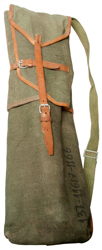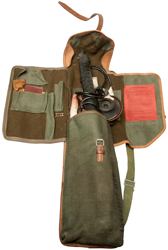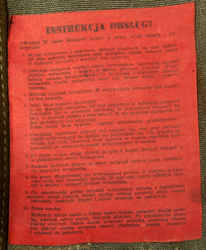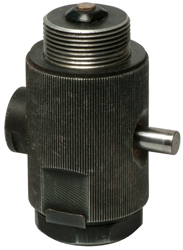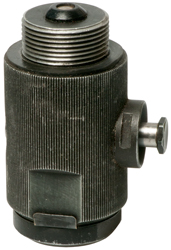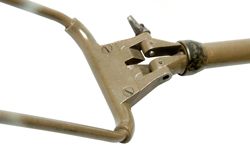Polish W3-P Mine Detector
© Brooke Clarke 2021 
|
Description
Battery
Battery Adapter
Photos
Patents
Related
References
Links
Background
While working on the Metal Locators web page discovered this unit. Ordered from eBay seller only-army in the UK and got it in two days via Fedex.
eBay title: RARE Polish Army Metal / Mine Detector Set With Canvas Leather Pouch Detecting
There is a Wiki page: Polish Mine Detector - maybe this model used from 1942 until 1995. Over 100,000 of these were made. This includes Mk I, Mk II, Mk III and Mk IV versions.
The Popular Science article "Detector Spots Buried Mines (May 1943, pg 93) shows a buzzer driving a Wheatstone bridge (Wiki) and headphones listening for a null. One of the legs of the bridge is a coil which becomes unbalanced if near any metal. Note non ferrous metals lower coil inductance and ferrous metals raise it.
An improvement may be to use an Maxwell Bridge (Wiki) or maybe better an Anderson Bridge (Wiki).
Circuit Globe: Anderson Bridge - the balancing capacitor is slightly different than the more common Maxwell bridge.
NBS: Measurement of Inductance by ANderson's Method using Alternating Currents and a Vibration Galvanometer. - Fig 1 is Maxwell's method where the balancing capacitor is in the bridge leg opposite the inductor. This requires setting two variable bridge arms in an iterative manner because the two adjustments interact. In the Anderson bridge the two adjustments are independent of each other making it much easier to adjust.
If this mine detector uses the Anderson bridge I suspect the capacitor is part of the design since the inductance of the search coil is known and fixed. That only leaves a single variable resistance to be adjusted to balance the bridge.
Problem
There is no manual booklet and no idea of what battery is needed.
From the red cloth short Instruction Manual item 2: the battery polarity is known to be cap=(-), i.e. positive (+) end of battery goes first into tube.
Description
ID No.: 137-11617-1166
See W3-P description below for decoding:
Mfg Plant: 137
s/n: 11617
Mfg Date: 11/66 = Nov 1966
Instruction Manual (from Fig 4)
There's a short Instruction Manual sewn into the carry bag.
NOTE: During longer work breaks, remove the batteries from the detector.
1. Take the detector out of its cover. Put the headphones over your ears. Unscrew both wing nuts at the hinge of the frame. Set the frame in the desired direction and tighten both nuts.
2. Unscrew the switch on the rear end cap of the detector. Check the cleanliness of the switch contacts and of the battery - clean if necessary. Insert the batteries with the contact pin (+) forward and fully tighten the switch. The switch thread must be clean and lubricated at all times.
3. Activate the on/off button. There should be an audible signal tone in the earbuds.
4. If there is no signal, check:
a) If the regulator knob is not set to the extreme position (carefully) or to the zero position,
b) Correct battery insertion,
c) Contact cleanliness and battery condition,
d) The headphone cord is not damaged or disconnected.
If there is still no signal - report the damage to the supervisor.
5. Turn the knob to set the tone of the signal so that it should be close (bass). When working in water, adjustments should be made after the detection frame has been immersed in water.
6. To work in position while standing, twist the 2 handle with you, and then press the switch.
7. During short breaks in work, switch off the batteries by pressing the on / off button.
8. For long-term work that do not require breaks, replace a switch with a stick and a screwdriver instead of the switch.
9. After finishing work, clean the detector with a cloth and brush, dry, remove the batteries, fold the frame, wrapping the hearing aid cord. Unscrew the handles around the handle and put them in the cover.
10. Praoa tentacle: twist the tip of the tentacle from the thin part of the stick, connect the bars with the body, screw in the tip of the tentacle, tighten with a wrench. Clean tentacles after finishing work. The tip of the tentacle, wipe with an oil-soaked cloth or apply a thin layer of grease. Then disconnect the tentacles and put them in the cover.
From web page on the W3-P Mine Detector
Decoding Number
"The last row of digits tells about its production date, e.g. 137 is the plant number in which it is produced 2546 the next number is the serial number and the next element 0290 is the month and year of production.
Battery
Power supply 4x 1.2V rechargeable batteries. hard to get them on the market, but they can be replaced with a 4.5 volt battery by cutting the cells and connecting them in series or R 14, 1.5 volt batteries. but you have to put them in a plastic tube with an outer diameter corresponding to battery charge in the detector and internal battery, corresponding to the diameter of the battery. This can be purchased at the REHAŁ pipe plumbing store.
Switch
I do not know what you have or the switch or the switch are included. this is what you block the battery hole. When you put in the power supply, you can hear a characteristic click in the headphones when you close the connector.
Knob
You have to turn the knob at the top left and right until you hear a hum in the headphones. Set the humming phase so that when you slide it over the metal, the sound rises rather than lowers it. There will be two such points. Be sure to turn right the frame with the head body because the frame takes the weight from the handle.
Have fun, a relatively efficient detector penetrates an object with a diameter of 25 cm up to 68-70 cm. How it works, it is not hard to spoil it. let me know if he talks. as we do not deal with it otherwise. I'll give you schematics and some more information ... GOOD LUCK >>>"Battery
The On/Off switch works by mechanically retracting the negative terminal (see Fig 7 and Fig 8 below). This connects the battery negative terminal to the ground, i.e. the metal body of the detector.
The battery compartment ID is too small to accept a common "C" battery, i.e. it is less than 0.992" (25.2mm).
There is a spring on the positive contact with a travel range of about 1-1/4".
The battery should be longer than 6.11" (155mm) and shorter than 7.36" (187 mm). The average is about 6.7" (170mm).
The OD of the battery might be near 0.89" (22.6mm).
2021 June 27 - after reading the translation from the W3-P Polish web page I tried using three AA cells, inside a plastic tube and a spring and the detector seems to be working.
The Energizer E91 is 1.988/1.949" long so three of them will be 5.964/5.847" which is shorter than 6.11" so something needs to be added to make that up.
2021 June 29 - purchased some plastic tubing to make some battery adapters.
These work.
Battery Adapter
To order the W3PBA battery adapter contact me. $10 to a U.S. address. You get the plastic 6" tube and a couple of spacer springs to go between the 3 AA batteries.
Install 3 each AA batteries with a spring between two of the batteries. Battery negative to cap.
Operation
While testing the battery voltage (see above) I also tried turning the knob. At first it was very tight (like from a stuck O-ring seal) but then moved. It's maybe a 3 turn pot.
Photos
Patents
Related
Aqua Locator Dip Needle or Miner's Compass
Blasting Machines & Land Mines -
Flux Gate Patents -
Metal Locators -
Newspaper article on Demining -
PRS-7 Portable Mine Detecting Set Metallic and Non-metallic
PSS-11 Mine Detecting Set - very very sensitive metal eyelets in your shoes cause a lot of false alarms.
Radio Direction Finding - the loop properties are the same for metal locators and RDF
References
Ref 1. The History of Land mines by Mike Croll,1998, 224 pgs, ISBN-13 : 978-0850526288 -
Links
PRC68, Alphanumeric Index of Web pages, Contact, Products for Sale
Page Created 2021 June 25

